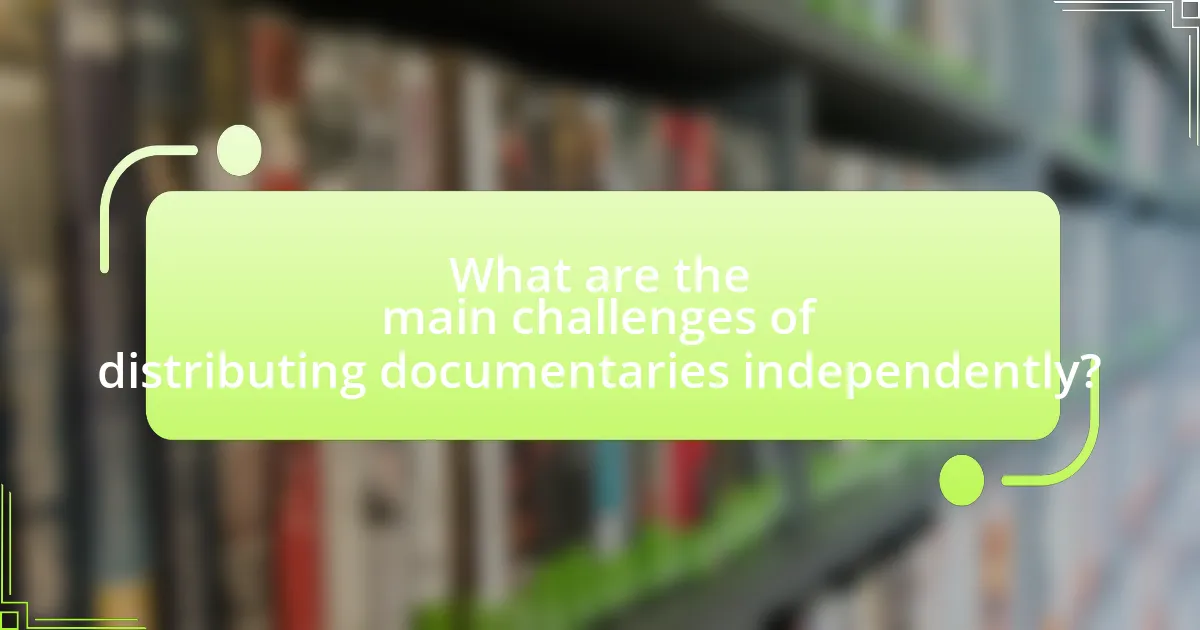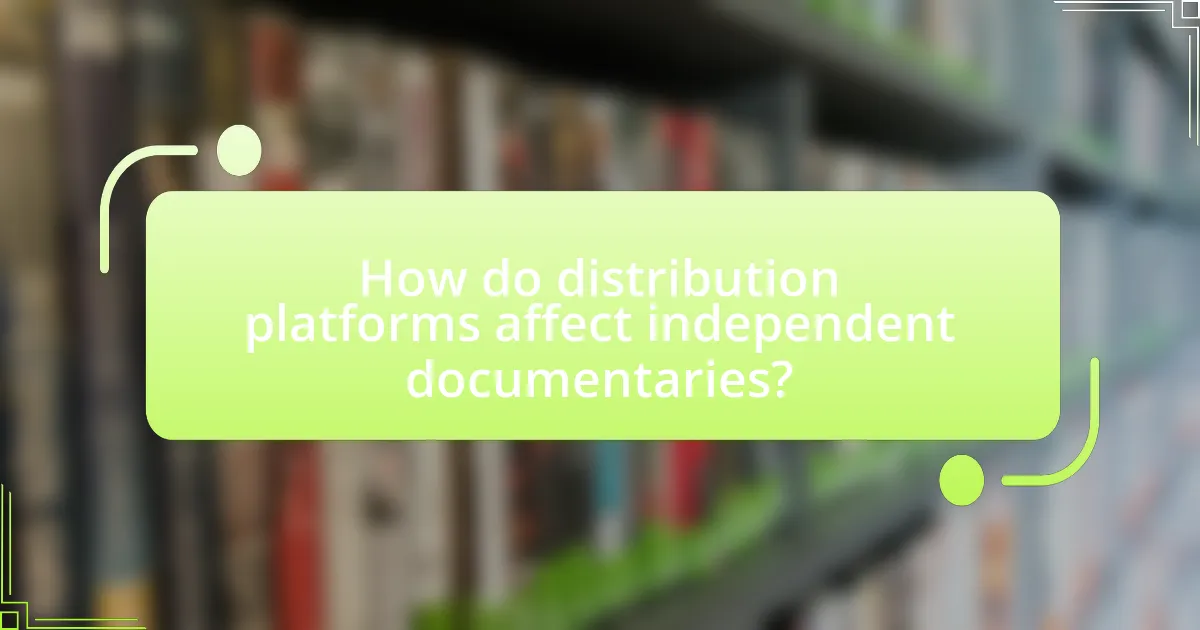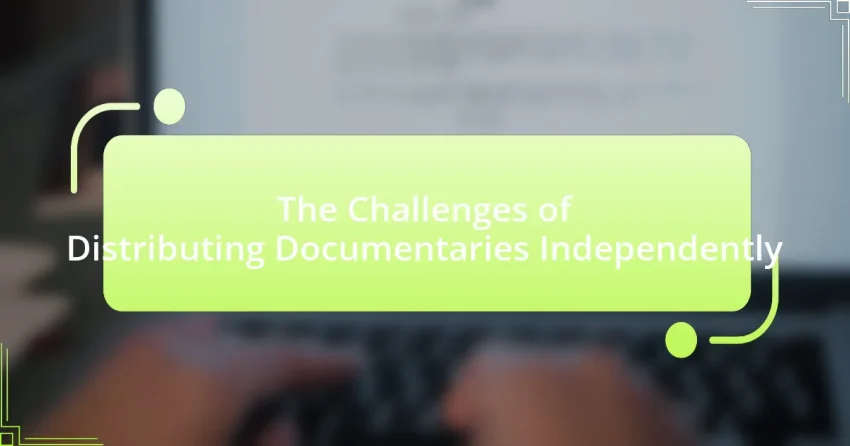The article examines the challenges faced by independent filmmakers in distributing documentaries. Key issues include limited access to distribution channels, financial constraints, and marketing difficulties, which hinder visibility and audience engagement. It discusses the impact of funding on distribution, common funding sources, and strategies for managing budgets effectively. Additionally, the article highlights the importance of audience engagement, the role of distribution platforms, and the legal and logistical challenges filmmakers encounter. Best practices for successful independent documentary distribution are also outlined, emphasizing the need for targeted marketing and leveraging digital platforms.

What are the main challenges of distributing documentaries independently?
The main challenges of distributing documentaries independently include limited access to distribution channels, financial constraints, and marketing difficulties. Independent filmmakers often struggle to secure placements in theaters or on streaming platforms due to competition with larger studios that have established relationships and resources. Financially, the costs associated with marketing and distribution can be prohibitive, as independent filmmakers typically operate with smaller budgets. Additionally, reaching target audiences effectively poses a challenge, as independent documentaries may lack the promotional power and visibility that larger productions enjoy, making it harder to generate interest and viewership.
How does the lack of funding impact independent documentary distribution?
The lack of funding severely restricts independent documentary distribution by limiting marketing reach and access to distribution channels. Independent filmmakers often rely on financial resources to promote their work, secure festival entries, and negotiate distribution deals. Without adequate funding, they struggle to reach audiences, resulting in lower visibility and fewer opportunities for screenings. For instance, a study by the Independent Film & Television Alliance found that 70% of independent films fail to secure distribution due to insufficient marketing budgets. This financial barrier ultimately hinders the ability of independent documentaries to compete with larger productions, reducing their impact and audience engagement.
What are the common sources of funding for independent documentaries?
Common sources of funding for independent documentaries include grants, crowdfunding, private investors, and production companies. Grants are often provided by organizations such as the Sundance Institute and the National Endowment for the Arts, which support documentary filmmakers through financial assistance. Crowdfunding platforms like Kickstarter and Indiegogo allow filmmakers to raise funds directly from the public, enabling them to gather small contributions from a large number of supporters. Private investors may also contribute capital in exchange for a share of potential profits, while production companies can provide funding in return for distribution rights or co-production agreements. These funding avenues are essential for independent filmmakers to finance their projects and navigate the challenges of distribution.
How can filmmakers effectively manage limited budgets?
Filmmakers can effectively manage limited budgets by prioritizing pre-production planning and utilizing cost-effective resources. Detailed budgeting and scheduling allow filmmakers to allocate funds wisely, ensuring that essential expenses are covered while minimizing waste. For instance, using local talent and crew can significantly reduce costs, as evidenced by the success of independent films that leverage community resources. Additionally, filmmakers can explore crowdfunding platforms, which have raised millions for projects, demonstrating a viable alternative to traditional funding methods. By focusing on these strategies, filmmakers can maximize their limited budgets while maintaining production quality.
What role does audience engagement play in independent documentary distribution?
Audience engagement is crucial in independent documentary distribution as it directly influences the film’s visibility and success. Engaged audiences are more likely to share content, attend screenings, and participate in discussions, which amplifies the documentary’s reach. For instance, a study by the Sundance Institute found that documentaries with strong audience interaction on social media platforms saw a 30% increase in viewership compared to those with minimal engagement. This highlights that fostering a community around the documentary not only enhances its distribution potential but also builds a loyal viewer base that can support future projects.
How can filmmakers identify and reach their target audience?
Filmmakers can identify and reach their target audience by conducting thorough market research and utilizing data analytics tools. Market research helps filmmakers understand demographic factors such as age, gender, interests, and viewing habits, which are crucial for defining their audience. Data analytics tools, such as Google Analytics and social media insights, provide concrete metrics on audience engagement and preferences, allowing filmmakers to tailor their marketing strategies effectively. For instance, a study by the Pew Research Center indicates that 73% of adults in the U.S. use social media, making it a vital platform for filmmakers to engage with potential viewers directly. By combining these methods, filmmakers can create targeted marketing campaigns that resonate with their identified audience, increasing the likelihood of successful distribution.
What strategies can be employed to build a loyal viewer base?
To build a loyal viewer base, content creators should focus on consistent quality, audience engagement, and targeted marketing. Consistent quality ensures that viewers can rely on the content for entertainment or information, fostering trust and loyalty. Engaging with the audience through social media, feedback loops, and community-building activities enhances viewer connection and investment in the content. Targeted marketing, such as utilizing analytics to understand viewer preferences and demographics, allows creators to reach the right audience effectively. Research indicates that 70% of viewers are more likely to return to content that actively engages them, highlighting the importance of these strategies in cultivating loyalty.

How do distribution platforms affect independent documentaries?
Distribution platforms significantly impact independent documentaries by providing essential access to wider audiences and facilitating revenue generation. These platforms, such as streaming services and digital marketplaces, enable filmmakers to bypass traditional distribution barriers, allowing for direct engagement with viewers. For instance, platforms like Netflix and Amazon Prime Video have invested in acquiring independent films, which increases visibility and potential viewership. According to a 2021 report by the Independent Film & Television Alliance, independent films that utilized digital distribution channels saw a 30% increase in audience reach compared to those relying solely on traditional methods. This shift not only democratizes access to content but also enhances the potential for financial success, as independent filmmakers can monetize their work through various revenue models offered by these platforms.
What are the advantages and disadvantages of various distribution platforms?
Various distribution platforms offer distinct advantages and disadvantages for independent documentary filmmakers. Advantages include wider audience reach through platforms like Netflix and Amazon Prime, which provide access to millions of subscribers, enhancing visibility and potential revenue. Additionally, platforms such as Vimeo allow for direct sales and rentals, giving filmmakers more control over pricing and distribution terms.
Conversely, disadvantages include high competition on major platforms, making it difficult for independent documentaries to stand out. Furthermore, many platforms impose strict content guidelines and revenue-sharing models that can limit profitability. For instance, platforms may take a significant percentage of sales, reducing the filmmaker’s earnings. Additionally, reliance on third-party platforms can lead to loss of control over the distribution process and audience engagement.
How do streaming services compare to traditional media outlets for documentaries?
Streaming services offer greater accessibility and a wider variety of documentaries compared to traditional media outlets. Unlike traditional outlets, which often have limited programming schedules and geographic restrictions, streaming platforms provide on-demand access to a vast library of documentary content, allowing viewers to watch at their convenience. For instance, platforms like Netflix and Amazon Prime Video have invested heavily in original documentary productions, resulting in a significant increase in the quantity and diversity of available films. According to a 2021 report by the Motion Picture Association, streaming services accounted for over 50% of documentary viewership, highlighting their dominance in the market. This shift has enabled independent filmmakers to reach broader audiences without the constraints typically associated with traditional distribution channels.
What are the emerging platforms for independent documentary distribution?
Emerging platforms for independent documentary distribution include streaming services like Vimeo On Demand, Amazon Prime Video Direct, and platforms such as DocuWare and FilmFreeway. These platforms provide filmmakers with the ability to reach audiences directly, bypassing traditional distribution channels. For instance, Vimeo On Demand allows creators to set their own pricing and retain a larger share of revenue compared to conventional distributors. Additionally, Amazon Prime Video Direct offers filmmakers access to a vast audience while providing tools for marketing and analytics. These platforms are increasingly popular as they empower independent filmmakers to maintain creative control and maximize their earnings.
How can filmmakers leverage social media for distribution?
Filmmakers can leverage social media for distribution by utilizing platforms like Facebook, Instagram, and Twitter to reach and engage their target audience directly. These platforms allow filmmakers to share trailers, behind-the-scenes content, and updates, creating buzz and anticipation around their projects. According to a 2021 study by the Pew Research Center, 69% of adults in the U.S. use Facebook, making it a vital tool for filmmakers to connect with potential viewers. Additionally, social media enables filmmakers to run targeted advertising campaigns, which can increase visibility and drive traffic to their films. By engaging with audiences through comments and shares, filmmakers can build a community that supports their work, ultimately enhancing distribution efforts.
What are the best practices for promoting documentaries on social media?
The best practices for promoting documentaries on social media include creating engaging content, utilizing targeted advertising, and leveraging partnerships with influencers. Engaging content, such as behind-the-scenes footage, trailers, and interactive posts, captures audience interest and encourages sharing. Targeted advertising on platforms like Facebook and Instagram allows filmmakers to reach specific demographics, increasing visibility among potential viewers. Collaborating with influencers who align with the documentary’s themes can amplify reach and credibility, as they often have established audiences that trust their recommendations. According to a study by the Pew Research Center, 69% of adults in the U.S. use social media, highlighting its effectiveness as a promotional tool for documentaries.
How can filmmakers use social media analytics to improve their distribution strategy?
Filmmakers can use social media analytics to enhance their distribution strategy by identifying audience preferences and engagement patterns. By analyzing metrics such as likes, shares, comments, and demographic data, filmmakers can tailor their marketing efforts to target specific viewer segments effectively. For instance, a study by the Pew Research Center indicates that 69% of adults in the U.S. use social media, providing filmmakers with a vast pool of data to understand which platforms yield the highest engagement for their content. This data-driven approach allows filmmakers to optimize release timing, select appropriate platforms, and create targeted promotional content, ultimately increasing the likelihood of reaching their desired audience and improving distribution outcomes.

What legal and logistical challenges do independent filmmakers face?
Independent filmmakers face significant legal and logistical challenges, including copyright issues, contract negotiations, and funding constraints. Copyright issues arise when filmmakers use existing materials without proper licensing, which can lead to legal disputes and financial penalties. Contract negotiations with actors, crew, and distributors often involve complex legal language that can be difficult to navigate, potentially resulting in unfavorable terms. Additionally, funding constraints limit the ability to secure necessary resources for production and distribution, making it challenging to complete projects. According to a 2020 report by the Independent Film & Television Alliance, 70% of independent filmmakers cite funding as their primary obstacle, highlighting the pervasive nature of these challenges in the industry.
How do copyright issues impact documentary distribution?
Copyright issues significantly impact documentary distribution by restricting the use of copyrighted materials, which can limit the content that filmmakers can include. Documentaries often rely on archival footage, music, and images that may be protected under copyright law, necessitating licenses that can be costly and time-consuming to obtain. For instance, a study by the International Documentary Association found that 70% of independent filmmakers reported facing challenges related to copyright clearance, which can delay release schedules and increase production costs. Consequently, these legal hurdles can hinder the ability of independent filmmakers to reach audiences effectively and profitably.
What steps can filmmakers take to ensure compliance with copyright laws?
Filmmakers can ensure compliance with copyright laws by obtaining necessary licenses for all copyrighted materials used in their documentaries. This includes securing permissions for music, footage, images, and any other content that is not original. Additionally, filmmakers should conduct thorough research to identify copyright holders and understand the specific terms of use for each piece of content. According to the U.S. Copyright Office, using copyrighted material without permission can lead to legal repercussions, including lawsuits and financial penalties. Therefore, maintaining clear documentation of all licenses and permissions is crucial for legal protection and compliance.
How can filmmakers navigate licensing agreements for music and footage?
Filmmakers can navigate licensing agreements for music and footage by thoroughly researching copyright laws and utilizing reputable licensing platforms. Understanding the distinction between public domain, Creative Commons, and licensed content is crucial, as it helps filmmakers identify which materials can be used without infringing on rights. Additionally, filmmakers should engage with music libraries and stock footage providers that offer clear licensing terms, ensuring they obtain the necessary permissions for their projects. According to the U.S. Copyright Office, unauthorized use of copyrighted material can lead to legal repercussions, emphasizing the importance of proper licensing in film production.
What logistical considerations must be addressed in the distribution process?
Logistical considerations in the distribution process include inventory management, transportation, and scheduling. Effective inventory management ensures that the right quantity of documentaries is available at the right time, preventing stockouts or excess inventory. Transportation logistics involve selecting appropriate shipping methods and routes to minimize costs and delivery times, which is crucial for independent distributors who may have limited budgets. Scheduling is essential to coordinate release dates and promotional activities, aligning them with target audience availability and market trends. These considerations are vital for maximizing reach and ensuring successful distribution in a competitive landscape.
How can filmmakers effectively manage distribution timelines?
Filmmakers can effectively manage distribution timelines by creating a detailed distribution plan that outlines key milestones and deadlines. This plan should include specific dates for festival submissions, marketing campaigns, and release schedules, allowing filmmakers to allocate resources efficiently and track progress. Research indicates that independent films that adhere to structured timelines are more likely to secure distribution deals, as timely submissions to festivals can enhance visibility and audience engagement. For instance, the Sundance Film Festival has specific deadlines for submissions, and films that meet these deadlines often gain significant attention, leading to better distribution opportunities.
What are the common pitfalls in the distribution logistics of documentaries?
Common pitfalls in the distribution logistics of documentaries include inadequate market research, poor audience targeting, and ineffective distribution channels. Inadequate market research can lead to a misalignment between the documentary’s content and audience interests, resulting in low engagement and viewership. Poor audience targeting often stems from a lack of understanding of demographic preferences, which can hinder promotional efforts and reduce the documentary’s reach. Ineffective distribution channels, such as relying solely on traditional platforms without exploring digital options, can limit accessibility and visibility, ultimately impacting the documentary’s success. These pitfalls highlight the importance of strategic planning and execution in the distribution process to ensure that documentaries reach their intended audiences effectively.
What are the best practices for successfully distributing documentaries independently?
The best practices for successfully distributing documentaries independently include leveraging digital platforms, building a targeted audience, and utilizing social media for promotion. Digital platforms such as Vimeo, Amazon Prime, and YouTube provide accessible avenues for independent filmmakers to reach viewers directly, bypassing traditional distribution channels. Building a targeted audience involves identifying and engaging with specific demographics that resonate with the documentary’s subject matter, which can enhance viewer interest and support. Utilizing social media for promotion allows filmmakers to create buzz, share trailers, and connect with potential viewers, increasing visibility and engagement. According to a 2020 report by the Independent Film & Television Alliance, independent films that effectively utilize digital marketing strategies see a 30% increase in audience reach compared to those that do not.
